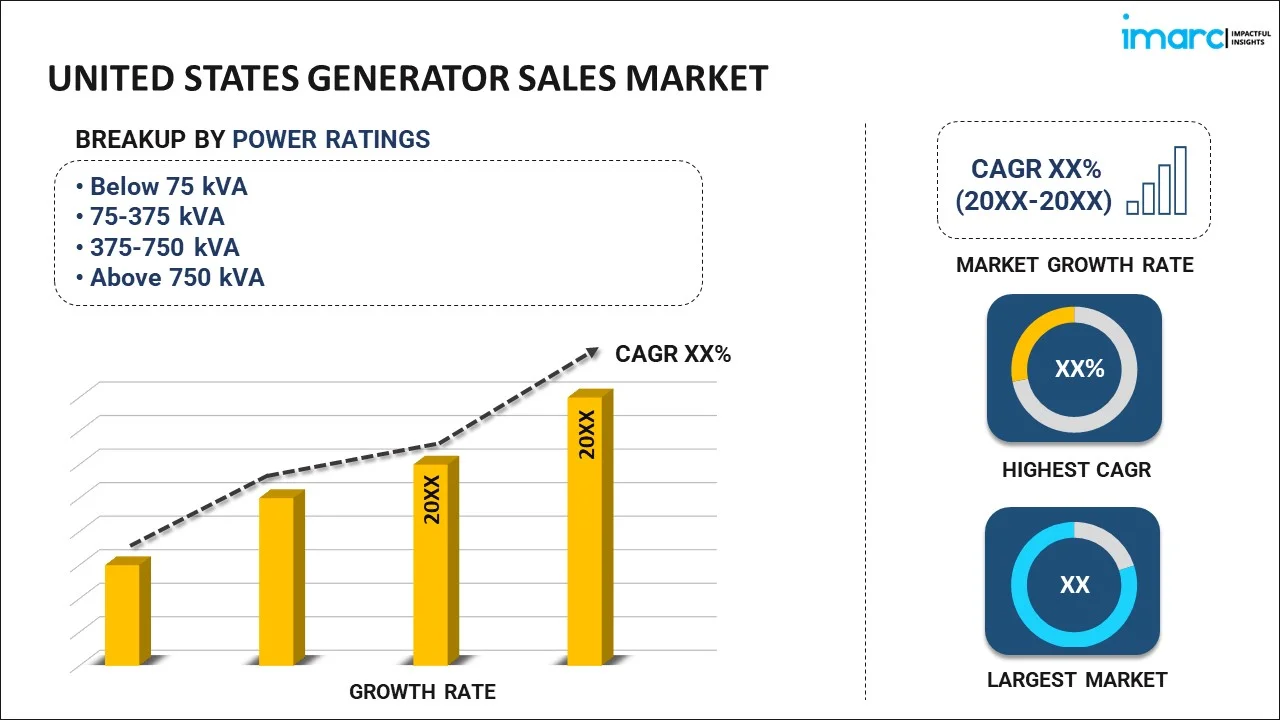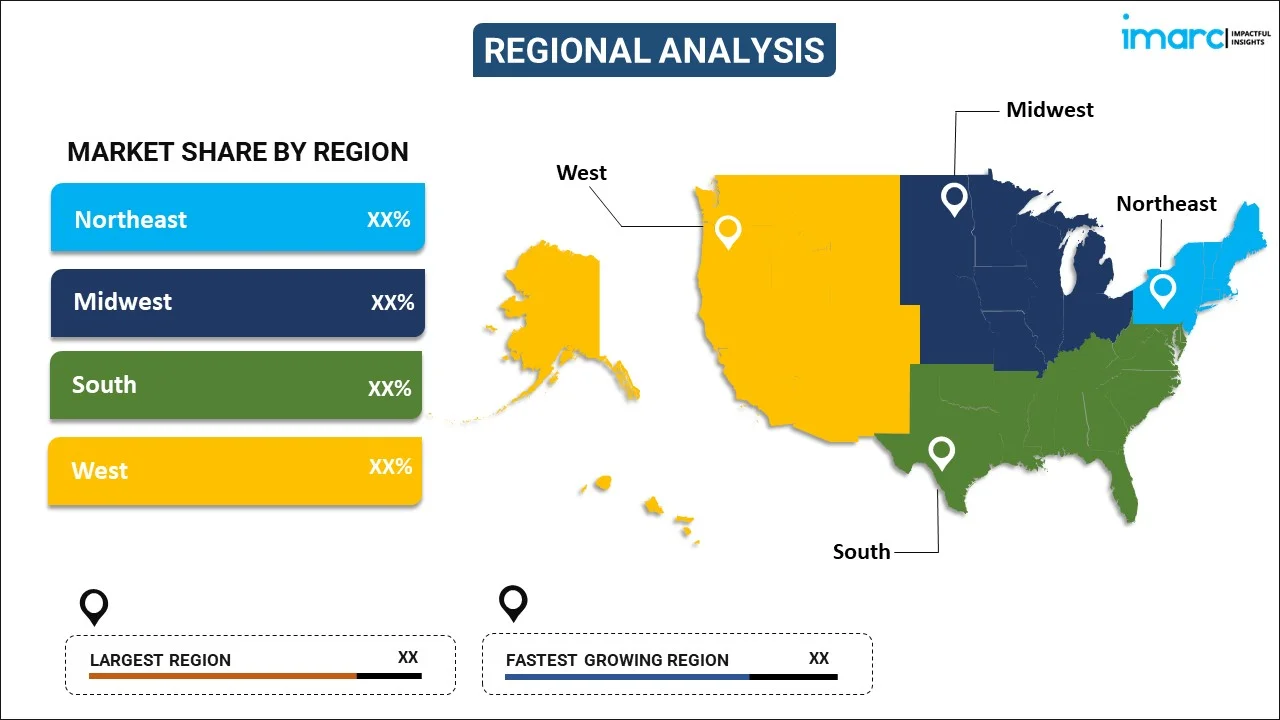
United States Generator Sales Market Report by Power Rating (Below 75 kVA, 75-375 kVA, 375-750 kVA, Above 750 kVA), Fuel Type (Diesel, Gas, and Others), Application (Continuous Load, Peak Load, Standby Load), End Use Industry (Industrial, Commercial, Residential), and Region 2024-2032
Market Overview:
United States generator sales market size reached US$ 5.5 Billion in 2023. Looking forward, IMARC Group expects the market to reach US$ 8.5 Billion by 2032, exhibiting a growth rate (CAGR) of 4.94% during 2024-2032. The increasing frequency and impact of natural disasters, such as hurricanes, earthquakes, and floods, that can drive the demand for generators as a reliable source of power during emergency situations, is fueling the market.
|
Report Attribute
|
Key Statistics
|
|---|---|
|
Base Year
|
2023
|
|
Forecast Years
|
2024-2032
|
|
Historical Years
|
2018-2023
|
|
Market Size in 2023
|
US$ 5.5 Billion |
|
Market Forecast in 2032
|
US$ 8.5 Billion |
| Market Growth Rate 2024-2032 | 4.94% |
Generator sales refer to the commercial transactions involving the purchase and distribution of electrical generators. These devices are crucial for providing backup power during outages or serving as the primary power source in off-grid locations. Generator sales encompass a wide range of industries, including construction, healthcare, manufacturing, and residential sectors. Businesses and individuals often invest in generators to ensure uninterrupted operations, safeguard critical equipment, and maintain essential services. The market for generator sales is influenced by factors such as power demand, infrastructure development, and emergency preparedness. As technology advances, the industry sees innovations in fuel efficiency, environmental sustainability, and smart connectivity features. In summary, generator sales play a pivotal role in supporting reliable and resilient power solutions across various sectors, contributing to the overall stability of power infrastructure.
United States Generator Sales Market Trends:
The generator sales market in the United States is witnessing robust growth, primarily propelled by several key drivers that collectively shape its trajectory. Firstly, the increasing regional demand for reliable and uninterrupted power supply has emerged as a primary catalyst for generator sales. This burgeoning need is fueled by expanding industrial activities, rising urbanization, and the relentless pace of technological advancements, all of which contribute to a heightened reliance on consistent power sources. Moreover, the escalating frequency and intensity of natural disasters, such as hurricanes, earthquakes, and wildfires, have underscored the importance of backup power solutions, further driving the generator market. As businesses and individuals alike recognize the vulnerability of conventional power grids, there is a growing inclination towards investing in generators for emergency preparedness. This trend is especially pronounced in regions prone to extreme weather conditions. Furthermore, the increasing adoption of renewable energy sources, such as solar and wind power, has generated a complementary demand for backup generators. These generators serve as a reliable backup during periods of intermittent renewable energy generation, ensuring a continuous power supply. In essence, the regional generator sales market is propelled by a confluence of factors, ranging from the need for uninterrupted power in a technology-driven world to the imperative of disaster resilience and the evolving landscape of renewable energy integration.
United States Generator Sales Market Segmentation:
IMARC Group provides an analysis of the key trends in each segment of the market, along with forecasts at the country level for 2024-2032. Our report has categorized the market based on power rating, fuel type, application, and end use industry.
Power Rating Insights:

- Below 75 kVA
- 75-375 kVA
- 375-750 kVA
- Above 750 kVA
The report has provided a detailed breakup and analysis of the market based on the power rating. This includes Below 75 kVA, 75-375 kVA, and 375-750 kVA, and Above 750 kVA.
Fuel Type Insights:
- Diesel
- Gas
- Others
A detailed breakup and analysis of the market based on fuel type have also been provided in the report. This includes diesel, gas, and others.
Application Insights:
- Continuous Load
- Peak Load
- Standby Load
The report has provided a detailed breakup and analysis of the market based on the application. This includes continuous load, peak load, and standby load.
End Use Industry Insights:
- Industrial
- Utilities/Power Generation
- Oil and Gas
- Chemicals and Petrochemicals
- Mining and Metals
- Manufacturing
- Marine
- Construction
- Others
- Commercial
- IT and Telecom
- Healthcare
- Data Centers
- Others
- Residential
A detailed breakup and analysis of the market based on end use industry have also been provided in the report. This includes industrial (utilities/power generation, oil and gas, chemicals and petrochemicals, mining and metals, manufacturing, marine, construction, and others) commercial (IT and telecom, Healthcare, data centers, and others), and residential.
Regional Insights:

- Northeast
- Midwest
- South
- West
The report has also provided a comprehensive analysis of all the major regional markets, which include the Northeast, Midwest, South, and West.
Competitive Landscape:
The market research report has also provided a comprehensive analysis of the competitive landscape in the market. Competitive analysis such as market structure, key player positioning, top winning strategies, competitive dashboard, and company evaluation quadrant has been covered in the report. Also, detailed profiles of all major companies have been provided.
United States Generator Sales Market Report Coverage:
| Report Features | Details |
|---|---|
| Base Year of the Analysis | 2023 |
| Historical Period | 2018-2023 |
| Forecast Period | 2024-2032 |
| Units | US$ Billion |
| Scope of the Report | Exploration of Historical and Forecast Trends, Industry Catalysts and Challenges, Segment-Wise Historical and Predictive Market Assessment:
|
| Power Ratings Covered | Below 75 kVA, 75-375 kVA, 375-750 kVA, Above 750 kVA |
| Fuel Types Covered | Diesel, Gas, Others |
| Applications Covered | Continuous Load, Peak Load, Standby Load |
| End Use Industries Covered |
|
| Regions Covered | Northeast, Midwest, South, West |
| Customization Scope | 10% Free Customization |
| Report Price and Purchase Option | Single User License: US$ 2999 Five User License: US$ 3999 Corporate License: US$ 5499 |
| Post-Sale Analyst Support | 10-12 Weeks |
| Delivery Format | PDF and Excel through Email (We can also provide the editable version of the report in PPT/Word format on special request) |
Key Questions Answered in This Report:
- How has the United States generator sales market performed so far and how will it perform in the coming years?
- What has been the impact of COVID-19 on the United States generator sales market?
- What is the breakup of the United States generator sales market on the basis of power rating?
- What is the breakup of the United States generator sales market on the basis of fuel type?
- What is the breakup of the United States generator sales market on the basis of application?
- What is the breakup of the United States generator sales market on the basis of end use industry?
- What are the various stages in the value chain of the United States generator sales market?
- What are the key driving factors and challenges in the United States generator sales?
- What is the structure of the United States generator sales market and who are the key players?
- What is the degree of competition in the United States generator sales market?
Key Benefits for Stakeholders:
- IMARC’s industry report offers a comprehensive quantitative analysis of various market segments, historical and current market trends, market forecasts, and dynamics of the United States generator sales market from 2018-2032.
- The research report provides the latest information on the market drivers, challenges, and opportunities in the United States generator sales market.
- Porter's five forces analysis assist stakeholders in assessing the impact of new entrants, competitive rivalry, supplier power, buyer power, and the threat of substitution. It helps stakeholders to analyze the level of competition within the United States generator sales industry and its attractiveness.
- A competitive landscape allows stakeholders to understand their competitive environment and provides an insight into the current positions of key players in the market.
Need more help?
- Speak to our experienced analysts for insights on the current market scenarios.
- Include additional segments and countries to customize the report as per your requirement.
- Gain an unparalleled competitive advantage in your domain by understanding how to utilize the report and positively impacting your operations and revenue.
- For further assistance, please connect with our analysts.
 Inquire Before Buying
Inquire Before Buying
 Speak to an Analyst
Speak to an Analyst
 Request Brochure
Request Brochure
 Request Customization
Request Customization




.webp)




.webp)












